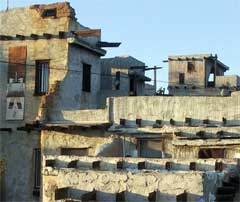The desert splendor of the Coachella Valley has been created, in part, by an unusual geological feature: the periodic movement of the San Andreas Fault.
To address the ever- present threat of earthquakes, 15 months ago local museums and historical societies of the valley formed a group called the Coachella Valley Emergency Preparedness Network (CVEPN). Members from 14 organizations met to develop an emergency plan, obtain cargo containers, and write grants to protect collections and structures in the event of any natural disaster. The group’s monthly meetings have been informative, encouraging, and well attended.
Our museum, Cabot’s Pueblo Museum in Desert Hot Springs, is relatively new. We have little professional infrastructure in place, and no professional museum personnel on our staff or board. We have yet to produce a proper inventory of our collection- in fact, we are still going through boxes to determine what our collection consists of. For us, CVEPN has proven invaluable.
CVEPN has provided us with a venue for talking through ideas with seasoned museum professionals and it has given us valuable learning opportunities, such as a class about light offered at the Agua Caliente Cultural Museum by staff from the Getty Center in Los Angeles. Asking the professionals we meet at CVEPN what they recommend as a “next step” for our institution has also led to illuminating discussions.
The passion for heritage, nature, art and architecture shared by members of CVEPN offers promise that alliances and agreements among our institutions will develop to support our shared missions. Now we are all excited to join others at the WMA Conference and share our concerns and aspirations for the future.
[Note: Ms. Maron's post is a preview of #WMA09 Session E2 "When Natural Disasters Hit - Safeguarding Culture through Sharing Resources" on Tuesday, October 27th from 10:55 am - 12:15 pm. Her session will also include presentations by Barbara Keedy Eastes, Vice President, Palm Desert Historical Society; and Mario Juarez, Representative, Palm Springs Air Museum. The discussion will be moderated by Ginger Ridgway, Curator/Director of Programs, Agua Caliente Cultural Museum.]










Comments
Barbara,
I'm fascinated by your project, in part because I lived in the south west (Tempe for graduate school, Payson later), but also because I run a non-profit, Heritance that provides tech support and training for free to museums. In particular, our newest project, Open Museum (also free & not-for-profit) may of interest to you. It's a participatory exhibit space and social network for museum lovers and a digital outreach tool for museums. It would allow you to "blog your collection", item by item as you take them out of the boxes and develop a network of fans who could participate in a range of ways. If you're interested, check out Open Museum and drop me an email. Either way, it would be fun to be in touch about your project.
The link to Open Museum is:
http://www.heritance.org
This is a great reminder of how valuable the collective knowledge and generous spirit of the museum community are. I remember opening our facility at the End of the Oregon Trail Interpretive Center fourteen years ago with much the same situation---many challenges and no seasoned museum professionals on staff. We were helped immensely back then---people like Alice Parman, Dan Crandall, Irene Zenev and Greta Brunschwyler among others--were very generous with their time and wisdom. This is a tradition, a torch, that has been passed on frequently through the medium of the annual conference. We gather, like people coming together annually around a harvest fire, and share.
Add new comment